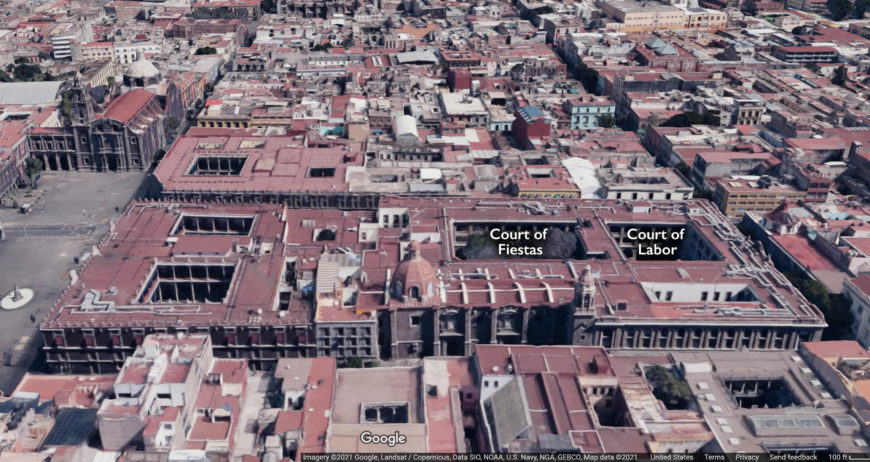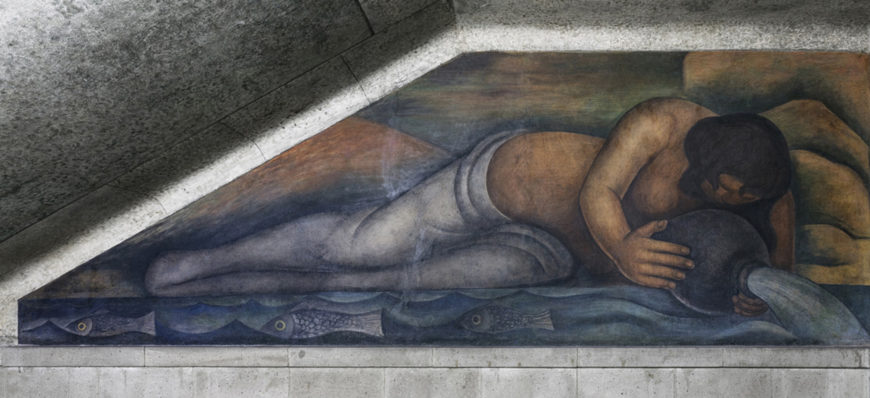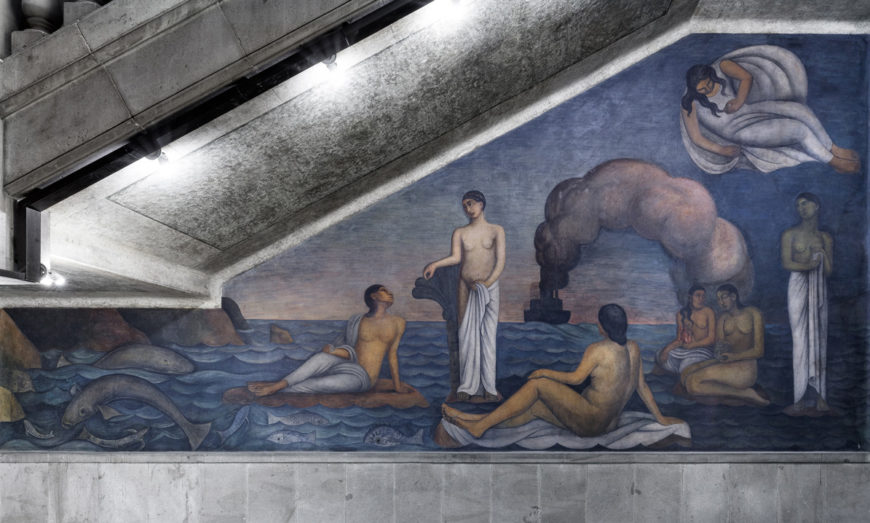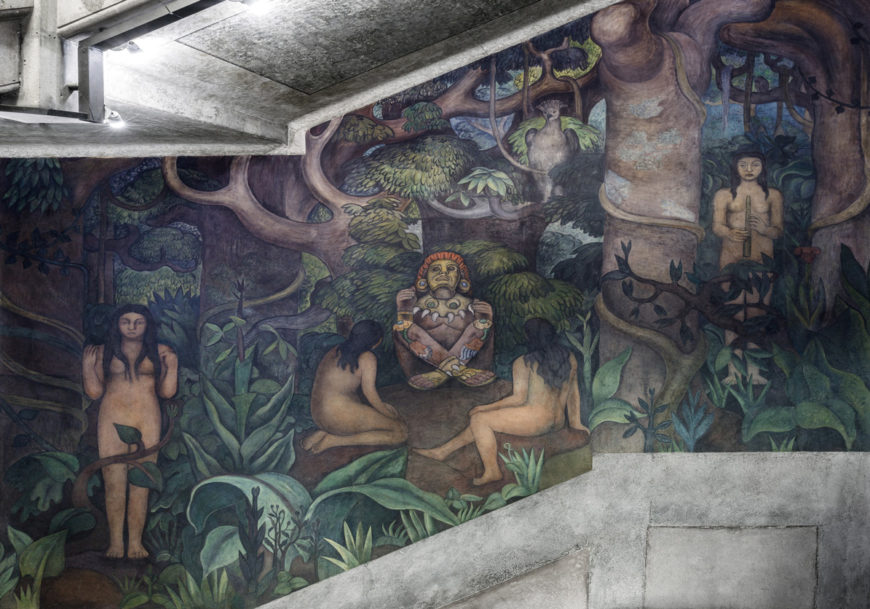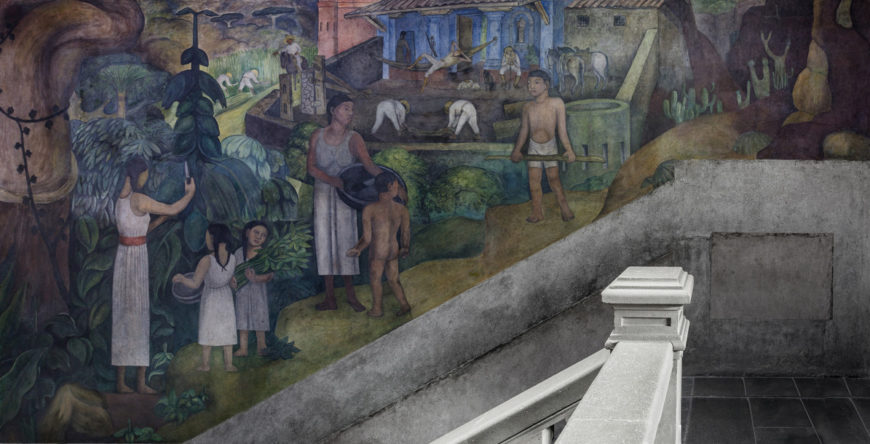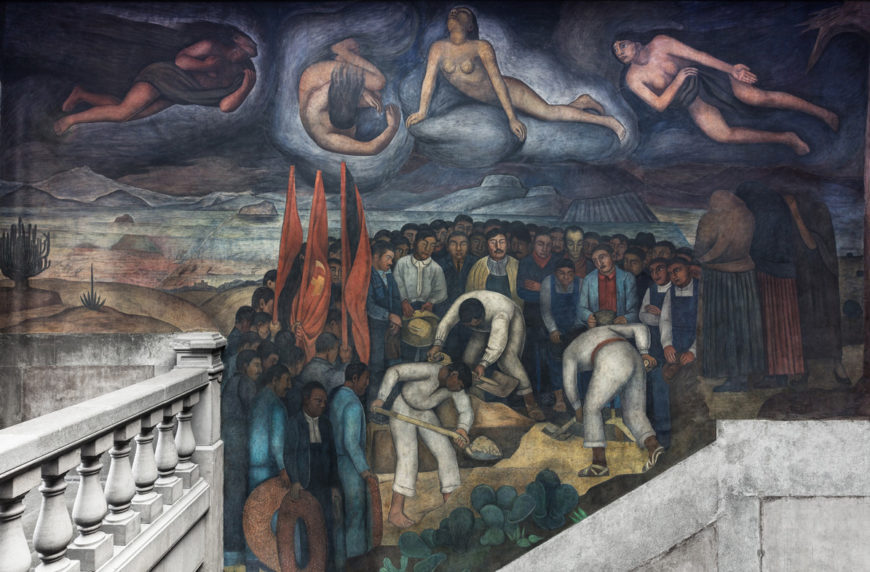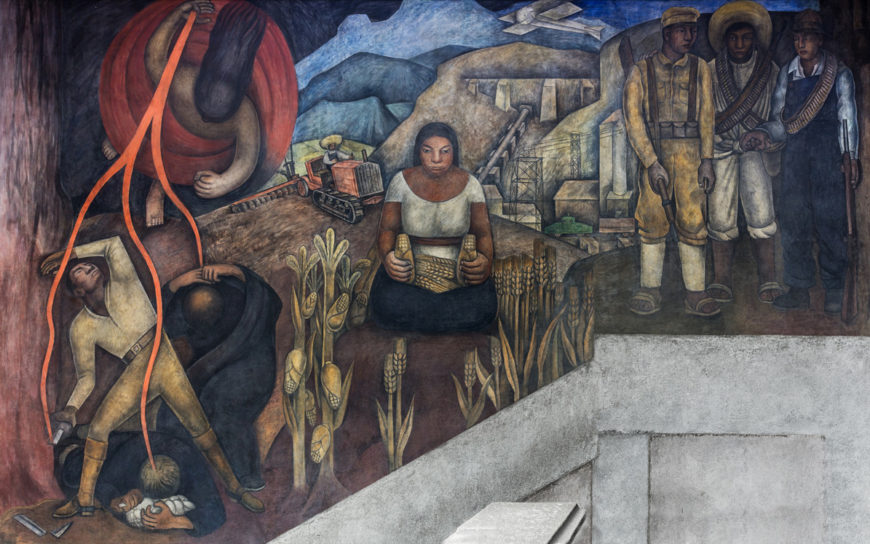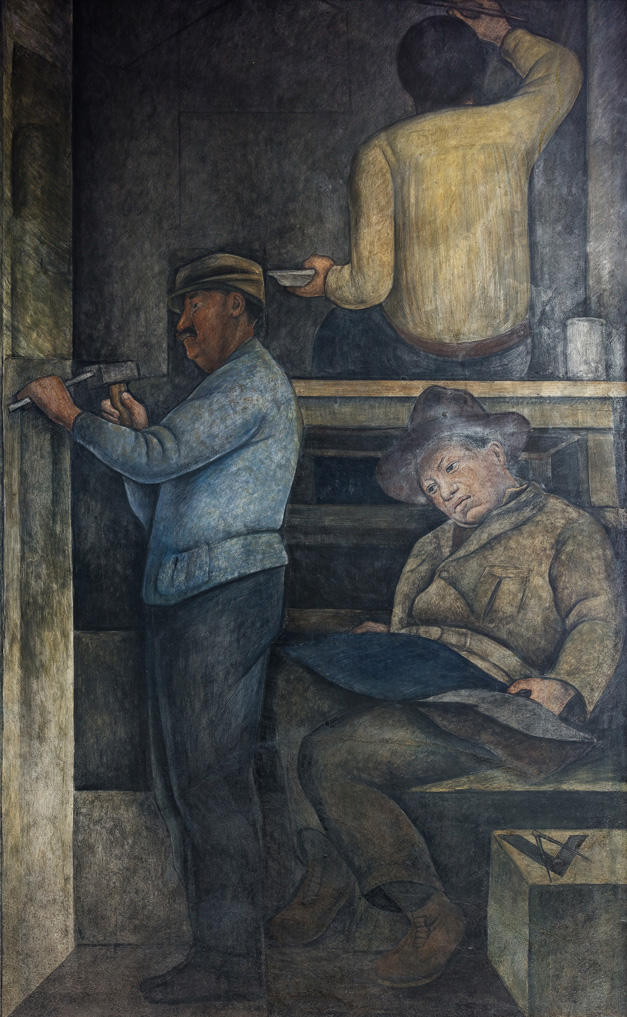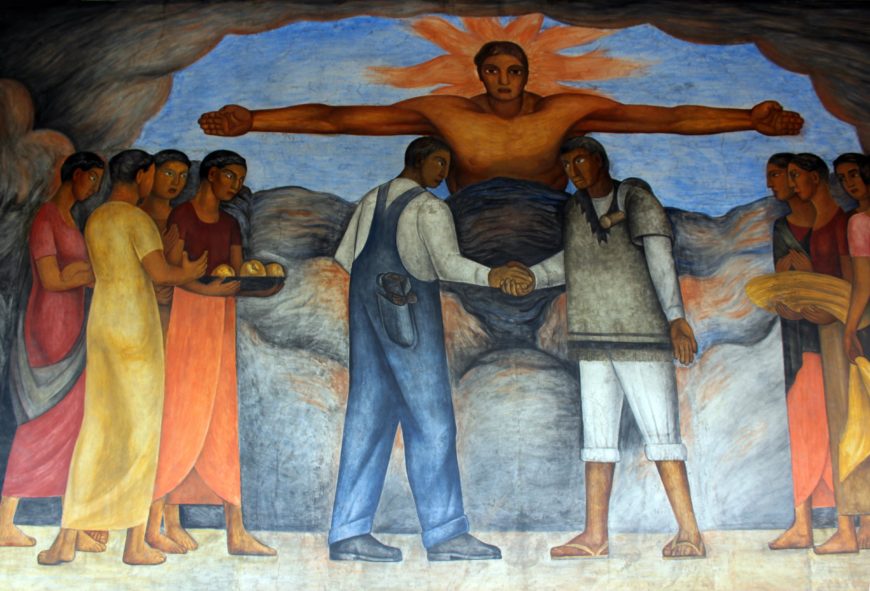
Diego Rivera, Fraternity (detail), third floor, Court of Labor, mural in the Secretaría de Educación Pública, Mexico City (photo: Megan Flattley)
Do you think that art can change the world? If so, what would that look like? Artists in Mexico had a particular vision of how their art could shape the world after the Mexican Revolution (1910–20). They believed that art had a unique role to play in restructuring their society after ten years of civil war. Many artists in postrevolutionary Mexico believed that revolutionary art should be public, collective, and not just for the elites, aligning their artistic goals with their socialist political goals. In two mural cycles at the Secretaría de Educación Pública (Ministry of Public Education, or SEP), muralist Diego Rivera not only represented the achievements of the Mexican Revolution, he also made a case for the importance of artists in furthering the revolutionary project.
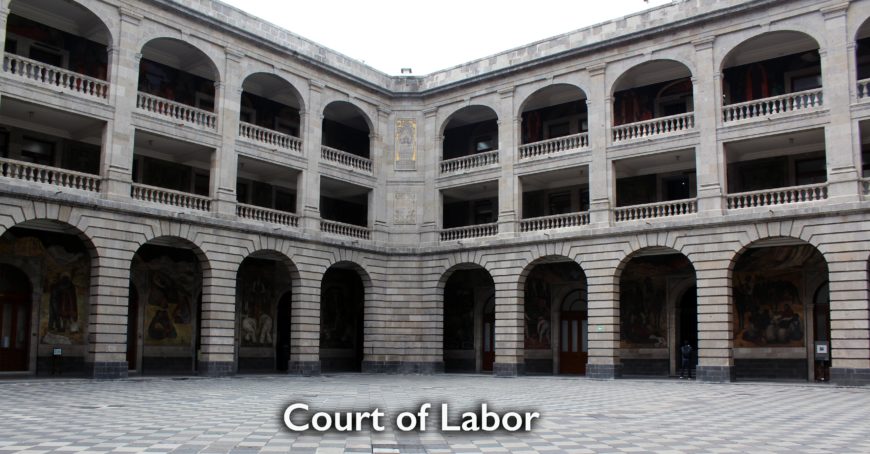
Diego Rivera, Court of Labor, murals in the Secretaría de Educación Pública, Mexico City (photo: Megan Flattley)
The Mexican Revolution
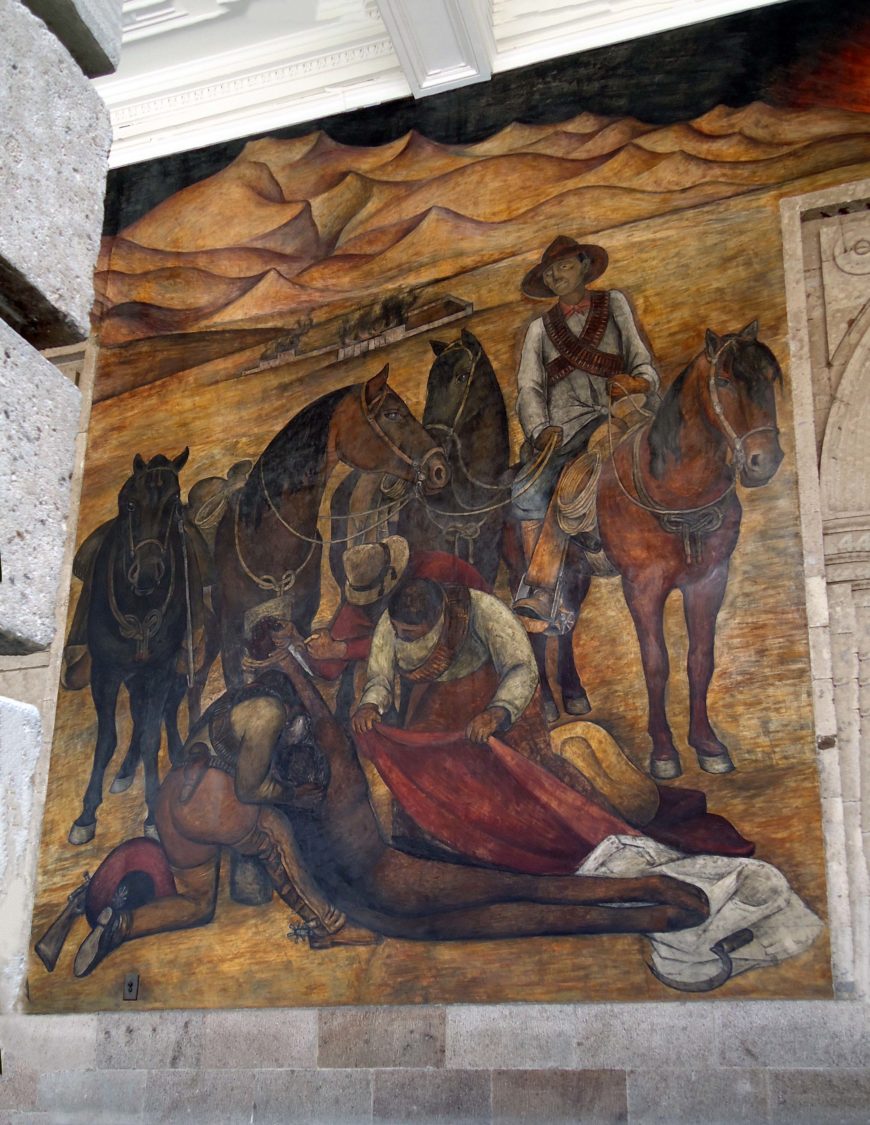
Diego Rivera, The Liberation of the Peon, 1923–24, first floor, Court of Labor, south wall mural in the Secretaría de Educación Pública, Mexico City (photo: Kgv88, CC BY-SA 3.0)
The Mexican Revolution was an armed struggle that lasted ten years, from 1910–20. The fighting began as a response to the unpopular 31-year dictatorship of Porfirio Díaz. The Revolution resulted in the current constitution of Mexico, which was written in 1917 and was then one of the most progressive documents in the world and would influence the drafting of the Soviet Constitution of 1918 and the Weimar Constitution of 1919. One of the most important articles of the 1917 constitution is article 27, which says that “all land and water within national territory is originally owned by the Nation.” This was a response to the pre-Revolutionary status quo wherein foreigners owned a majority of the land and resources. The Constitution also established the postrevolutionary emphasis on education by stipulating, in article 3, the basis for a free, mandatory, and secular education in Mexico.
This resulted in the postrevolutionary establishment of the Ministry of the SEP that would oversee schools as well as festivals and cultural production. The SEP also commissioned Mexican artists to paint murals on the walls of government buildings as part of a nationalist effort to create art that was Mexican, rather than influenced by Europe or the Spanish colonial heritage. These artistic works frequently featured imagery of the Mexican Revolution such as the revolutionary trio of the worker, the farmer, and the soldier, which allegorically represent the basic pillars of the revolution and its fight against land owners and foreign influence.
Diego Rivera was one of los tres grandes (the three great ones) that received many commissions from the Mexican state. In 1923, Rivera began to paint a mural cycle in the building that houses the Ministry of Public Education. Rivera painted 117 panels at the SEP building that covered two courtyards and three levels. The courtyards were divided thematically into a “Court of Labor” and a “Court of Fiestas.” On the first floor of the mural cycle in both courts, Rivera painted scenes of Mexican laborers, festivities, and cultural celebrations, while the second floor featured symbolic depictions of various types of intellectual labor (read more about the first and second floor murals). On the third floor, in the Court of Fiestas, after his return from the Soviet Union in 1928, Rivera depicted a “Corrido of the Agrarian Revolution” and a “Corrido of the Proletarian Revolution.”
In the stairwell as well as in the “Court of Labor” on the third floor of the SEP cycle, however, Rivera was more interested in the role of the artist in the revolutionary process.
Stairwell
Unlike the scenes across both Courts on each of the three floors, which were separated by archways and other architectural divisions, the stairwell offered Rivera an uninterrupted expanse of space to paint and experiment with different compositions and perspectives. The murals in the stairwell offer an expansive view of Mexico’s topography that begins at the sea-level tropics and ascends to the volcanoes and mountains of the central plateau. In emphasizing the beauty of the natural environment of Mexico, the mural reflects the post-revolutionary project of centering Mexican culture and the Mexican landscape. Along the ascension of the stairwell, the Mexican people are similarly shown rising above the exploitation of the pre-Revolutionary status quo. Climbing the stairs, the viewer emerges on the third floor of the Court of Labor amidst the mural cycle known as The Apotheosis of the Mexican Revolution, echoing the Mexican people’s journey towards the social promises of the Revolution.
The first scenes in the stairwell depict the sea and imagery of abundance and innocence. Rivera depicts nude figures emerging from the sea in a classical treatment of the female form that recalls the art historical tradition of the Birth of Venus such as that by the Italian Renaissance artist Sandro Botticelli. Prior to his return to Mexico in 1921, Rivera had traveled around Italy to study the mural paintings of the Italian Renaissance.
The continuous scene transitions into that of the tropics then to the jungle where Rivera shows two nude figures seated before Xochipilli, the Aztec god of flowers. Rivera looked to a recently discovered statue of the deity in his first direct citation of a pre-Columbian figure. This is consequential because Rivera would increasingly study, cite, and collect pre-Columbian art work over the course of his career.
The embrace of Mexico’s pre-Columbian heritage was another critical cultural dimension of the post-revolutionary period and informed Rivera’s theory of revolutionary art. He wrote that it was through his understanding and incorporation of pre-Columbian art that he became “the first revolutionary painter in Mexico.” [1] Further, the representation of nude figures in an idyllic jungle scene recalls work such as Henri Rousseau’s The Dream. This reference demonstrates Rivera’s familiarity with the advances of the European avant-garde at the time and also demonstrates his skill in integrating multiple artistic traditions. By citing works of the European tradition within a mural that reflects the landscape of Mexico, Rivera demonstrates the unique contributions of his mural work—and by extension of Mexican Modernism—to an international discourse on modern art.
As the viewer ascends the staircase the jungle transitions to an hacienda scene where sugar cane cutters can be seen in the distance, overseen by a mounted hacendado, or owner. Recall that one of the primary motivations of the Mexican Revolution was the demand for land reform. Here, Rivera shows the pre-Revolutionary status quo of campesinos (peasants) made to work the land of a wealthy (and often foreign) landowner.
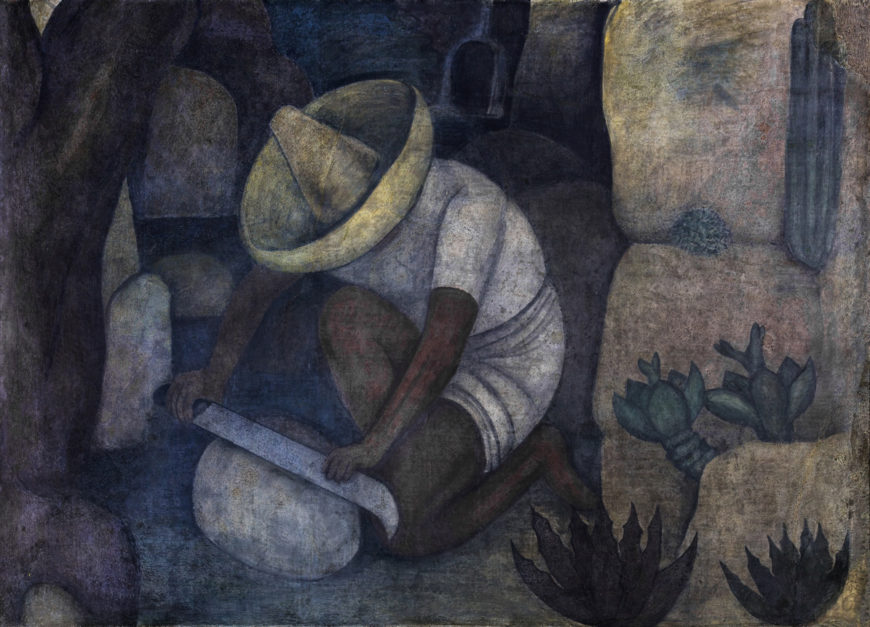
Diego Rivera, Sharpening a Machete, stairwell, mural in the Secretaría de Educación Pública, Mexico City
In a small scene a campesino is seen sharpening his machete, indicating that he will take arms in the Revolution. The emphasis on the machete may also reference the journal “El Machete,” that was recently founded by the Syndicate of Technical Workers, Painters, and Sculptors and which eventually became the journal of the Mexican Communist Party. By including this scene adjacent to that of the hacienda, Rivera indicates the revolutionary action that the oppressed campesinos could take against the landowning class.
At the top of the stairwell, within the Mexico City valley, the revolutionary narrative reaches its climax. In the first scene, titled The Burial, Rivera represents the return to the earth of those who have died in the revolutionary struggle—the red flags signal their worker status, as the color red was affiliated with the international struggle of the working class.
In Mechanization of the Countryside, to the left of a seated woman holding two ears of maíz (meant to evoke the Aztec goddess Xilonen), lightning strikes down three figures that represent the enemies of the Mexican people (according to the ideology of the post-revolutionary government): the clergy, capitalism, and the military.
In the distance, a tractor, airplane, power lines, and dam signal the modernization of the countryside, brought about by the power and solidarity of the revolutionary soldier, worker, and farmer depicted at the right, demonstrating the centrality of modernization to the postrevolutionary project.
The stairwell cycle concludes with a self-portrait of Rivera examining blueprints while his assistants prepare the wall behind him. Rivera painted this mural cycle in buon fresco, a very labor-intensive painting method that reinforced Rivera’s sense of his “artistic labor as a revolutionary work.” [2] Art historian Mary K. Coffey suggests that by placing the artist’s self-portrait at the top of the stairwell, the implication is that Rivera’s mural plays a critical role in Mexico’s transformation from an exploited past to a modern and egalitarian society. [3] This reading is reenforced by the murals in the third floor “Court of Labor” that the viewer sees upon emerging from the stairwell.
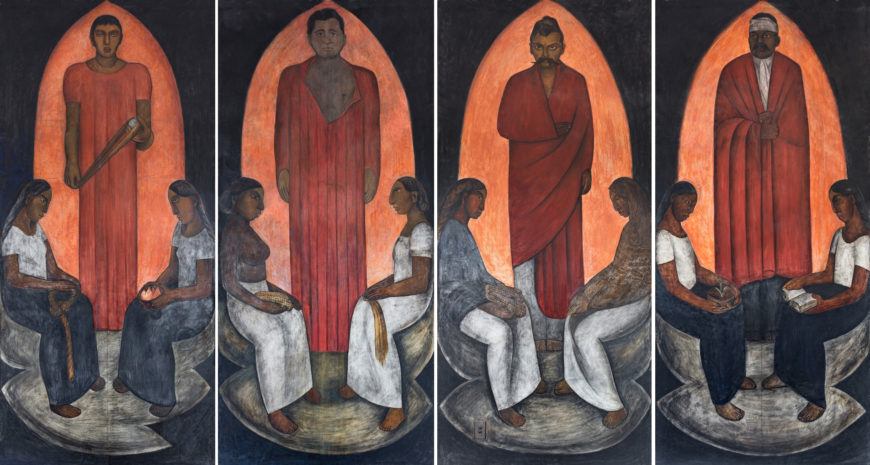
Diego Rivera, in order from right to left: Cuauhtémoc, Felipe Carrillo Puerto, Emiliano Zapata, and Otilio Montaño, Court of Labor, third floor, mural in the Secretaría de Educación Pública, Mexico City
The Court of Labor
On the north wall of the third floor of the Court of Labor, Rivera depicts the last Aztec emperor Cuauhtémoc (represented with a slingshot as David vs. the Goliath of the Spanish invaders. This refers to a story in the Christian Book of Samuel in which a young boy named David faces off against a giant named Goliath with only a slingshot. Today the phrase is colloquially used to refer to an underdog situation. Rivera employed the slingshot to refer to the distinct technological and military advantage that the Spanish conquistadors held over the Aztecs.
We also see three revolutionary heroes in in draped, red robes: the recently assassinated socialist governor of the Yucatán, Felipe Carrillo Puerto; leading figure of the Revolution, Emiliano Zapata; and revolutionary intellectual, Otilio Montaño. These figures suggest an affiliation with Byzantine icons, which are also depicted frontally and against a flat background. In this way, Rivera utilizes religious iconography to indicate the importance of these revolutionary figures in Mexican culture.
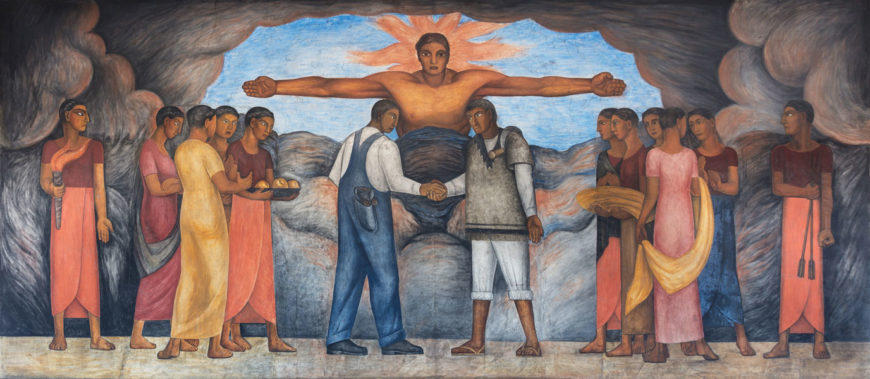
Diego Rivera, Fraternity, third floor, Court of Labor, mural in the Secretaría de Educación Pública, Mexico City
By invoking the martyrdom of Christian saints, Rivera posits that the martyrdom of such revolutionary figures fuels the rebirth of Mexican society. Across from the martyrs, on the east wall, Rivera repeats a central theme of the entire mural cycle—the unity in struggle of the industrial worker and the campesino—by showing the two figures shaking hands in Fraternity. Behind the two figures is the Greek god Apollo, deity of medicine and beauty.
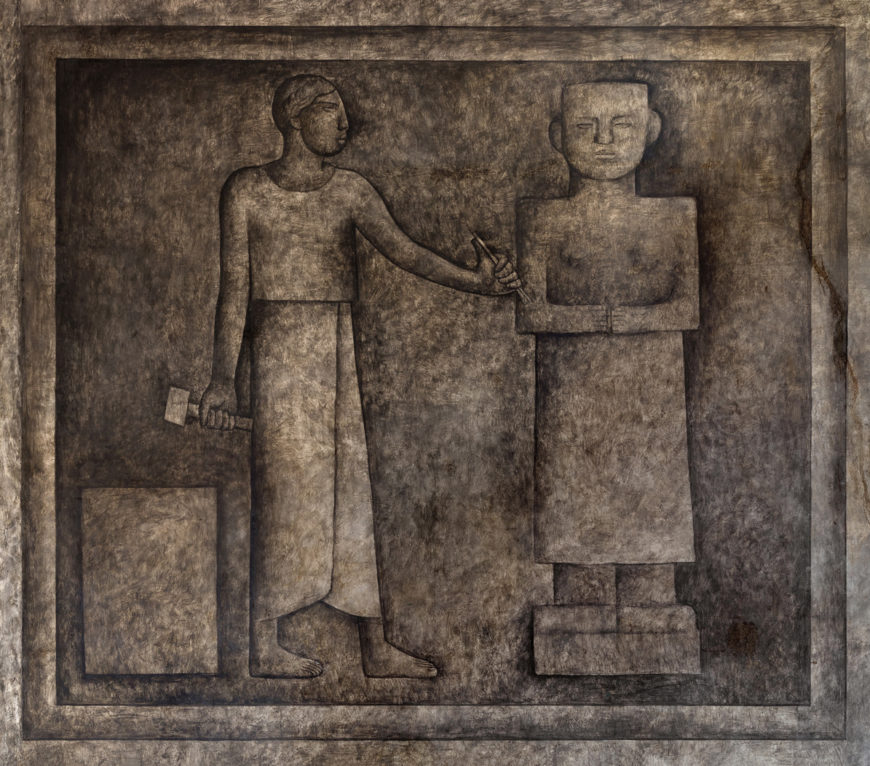
Diego Rivera, Sculpture, third floor, Court of Labor, mural in the Secretaría de Educación Pública, Mexico City
The Court of Labor is rounded out with scenes of allegories of agricultural abundance and the arts and sciences as humankind’s highest achievements on the south wall. Scholars have suggested that the pairing of the symbols of artistic activity with the martyred Revolutionary heroes indicates that Rivera viewed the arts as symbolic of an eternal rebirth and signify the reconstruction of society.
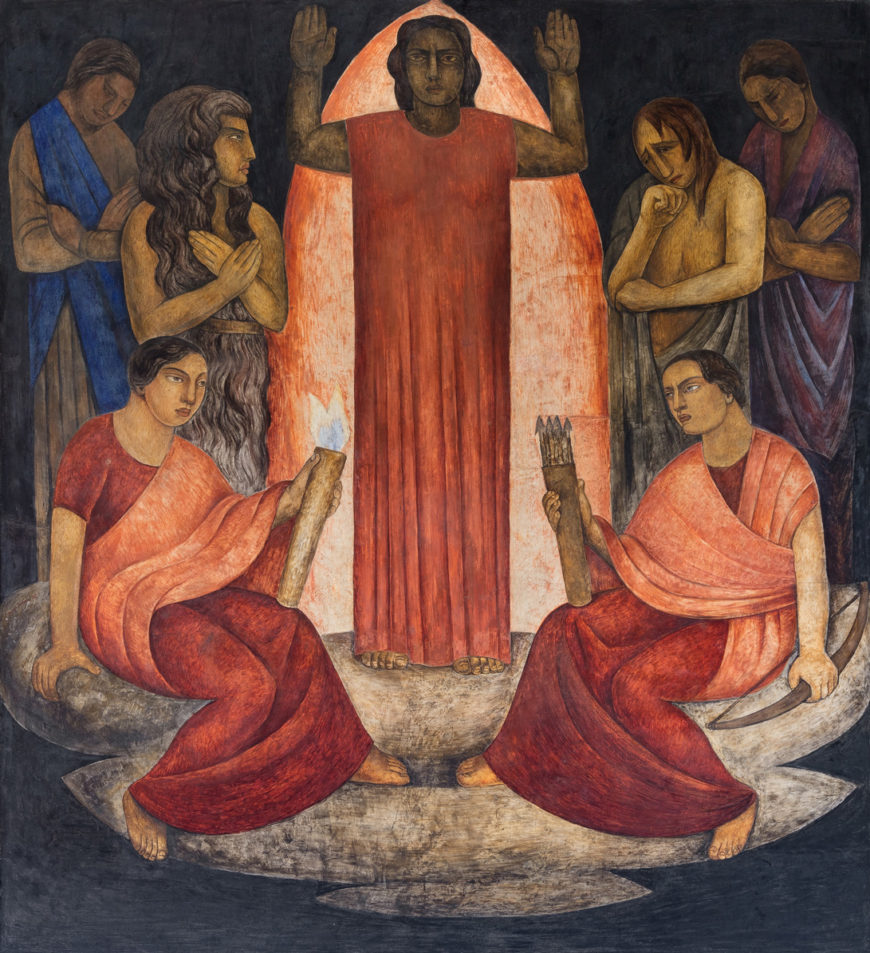
Diego Rivera, The Sciences, third floor, Court of Labor, mural in the Secretaría de Educación Pública, Mexico City
In this case, then, Apollo seems to have been included in Fraternity to “emphasize the idea of a social development in which this harmonic correspondence between art and science plays an important role.” [4]
Thus, in the stairwell and third floor Court of Labor scenes, Rivera articulated his vision of the centrality of the artist’s role in the postrevolutionary project and in social struggle more generally. He did so as he continued his project at the SEP to develop the formal and iconographic foundations of what we know today as Mexican Muralism.
Notes:
[1] Diego Rivera, “The revolutionary spirit in modern art,” The Modern Quarterly (Baltimore 6, no.3 (Fall 1932): p. 55.
[2] Diego Rivera, “Los primeros murales,” (1925), p. 51.
[3] Mary K. Coffey, “’All Mexico on a Wall’: Diego Rivera’s Murals at the Ministry of Public Education,” in Anreus, Alejandro et.al, Mexican Muralism: A Critical History (Berkeley: University of California Press, 2012), p. 70.
[4] Ida Rodríquez Prampolini, Muralismo Mexicano, 1920–1930: Catalogo Razonado I, (México, D.F.: Universidad Veracruzana: Instituto Nacional de Bellas Artes y Literatura: Universidad Nacional Autónoma de México: Fondo de Cultura Económica, 2012), p. 253.
Additional resources
Learn more about Latin American modernisms in a Reframing Art History chapter.
Alejandro Anreus, et.al, Mexican Muralism: A Critical History (Berkeley: University of California Press, 2012).
Jean Charlot, The Mexican Mural Renaissance, 1920–1925 (New York: Hacker Art Books, 1979).
Mary K. Coffey, “’All Mexico on a Wall’: Diego Rivera’s Murals at the Ministry of Public Education,” in Anreus, Alejandro et.al, Mexican Muralism: A Critical History (Berkeley: University of California Press, 2012).
David Craven, Diego Rivera As Epic Modernist (New York; London: G.K. Hall; Prentice Hall International, 1997).
Leonard Folgarait, Mural Painting and Social Revolution in Mexico, 1920–1940 (Cambridge; New York, NY: Cambridge UP, 1998).
Desmond Rochfort, Mexican Muralists: Orozco, Rivera, Siqueiros (San Francisco: Chronicle Books, 1993).
Ida Rodríquez Prampolini, Muralismo Mexicano, 1920–1930: Catalogo Razonado I, (México, D.F.: Universidad Veracruzana: Instituto Nacional de Bellas Artes y Literatura: Universidad Nacional Autónoma de México: Fondo de Cultura Económica, 2012).

